In the first half of this year, we have been going through global trauma from the pandemic. We are aware of racially motivated attacks against Asian communities due to COVID-19 and we have been speaking up on the heavy, intergenerational trauma of Black, Indigenous and People of Colour (BIPOC) communities across the world. These issues come up on our news feeds and in the conversations with our friends and family.
Advocating for social justice and dismantling systems of oppression is powerful, but can also be overwhelming and exhausting. Many of us are experiencing overwhelm and a heightened state of anxiety by the consumption and engagement of heavy topics so I brainstormed a few of my go-to art as therapy containment activities I have been working with to find lightness amidst the waves.
Practicing containment.
Containment means practicing healthy management of emotions, in times of crisis. Containment focuses on reconnecting to resources that are around us and coping strategies that work for us. If you are reading this blog post, you are probably looking for ways to take care of yourself so that you can show up or speak up with courage, compassion and awakened consciousness.
Here are creative ways to honour yourself, find containment and lightness as you intentionally engage with the heaviness around you:
Draw out your experience of the heaviness that is happening in the world today.
This directive can portray and validate what you are feeling and experiencing and can be a great alternative activity to practice mindfulness. Connecting our mind with our body is crucial during moments of overwhelm.
As any therapeutic art making goes, the process can be a contained expression of the heaviness we may be feeling. Containment in your art could look like the type of canvas/paper you draw on and the size of your drawing/painting itself, the materials you choose to work with, working with the language of emotions, a meta-verbal expression without the vulnerability of words to explain what is going on.
If you are looking for more containment, feel free to notice if your art piece needs a border, or somewhere safe to store the artwork. Some examples could be sticking on painter’s tape as borders you can decorate or leave as is after peeling off the tape, or finding an envelope to seal and store the art piece until you want to revisit it when you are ready. I created numerous art pieces thinking of this directive in mind.
In the back of my art pieces, I love to note down thoughts of what I reflected throughout the creative process. A message I found myself writing down is: “The various issues that deeply matter to others and yourself may be more similar than they appear.” This made me reflect on marginalized communities and movements that we may be advocating for: destigmatizing mental health, SDQTBIPoC folks (sick, disabled, queer, trans, Black, Indigenous, People of Colour), the LGBTQ2S+ community, feminism, immigrant lives and experiences, climate justice and more. There can be so much kindness when we can see the commonalities between what we all stand for.
What are the messages you express through your art making process?
Container exercise:
Visualize, design and draw out your container with these 3 components…
Design by visualizing and/or drawing the container.
The 3 components that goes into the design of the container:
1. Sturdiness: think about the material it is made out of. Think about the opacity, would you be able to see through what’s inside.
3. A 2-way system: so that you can put worries into the container and take things out of the container.
2. The inside needs to be comfortable: Part of the design is about how comforting the container is for your fears and worries to stay inside until you are ready to deal with it.
Give the container a name so you can call it out when you are feeling overwhelmed. Write down the name at the back of the drawing to remember it—so you can name it to tame it!
Practice by walking through a recent incident that has been a minor disturbance (a 5/10 in terms of how bothered you are by it) and visualize you putting that worry or fear into the container, sealing it up and storing it away. You can always revisit this worry and deal with it or talk about it when you are ready. Practice this exercise often to solidify and strengthen your memory of this coping strategy. The container is there to help hold what doesn’t serve you in this moment so that you can do what you want and need to do.
Do you have a fond memory?
Find a photograph of a time when you felt light or draw out a fond memory that brings you peace.
Practice grounding with a mindful visualization or representation of a memory to contain and help manage overwhelm. This exercise can help to bridge more neural connections to those relaxing experiences and let that hardworking nervous system to rest and recharge.
To strengthen the resource, something I learned in EMDR training is to “tap it in” by doing the butterfly hug (crossing your arms to each side of your shoulder or chest and tapping), tapping your hands on your laps, or tapping your feet—alternating left and right at one second intervals.
I walked through this exercise by reminiscing the 8 hours I spent in Paris last year. Taking in all the senses of what I saw, felt, sounds I heard, and foods I tasted and smelled.
Although our window of tolerance may have gotten smaller, our creativity to adapt to our surroundings have gotten stronger. I have witnessed so much resilience from people around me and from my clients: from the abundance resources and offerings online to ingenious ways we are connecting with those we love.
Hoping you can give these containment exercises a go and see if any of them can be added into your coping toolbox!















